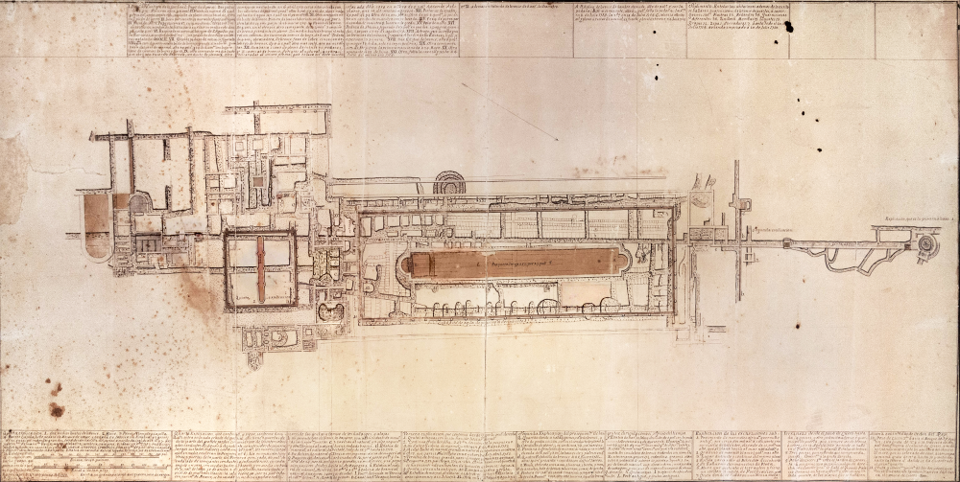Herculaneum, named after the hero Hercules, was a small town in Campania on the west coast of central Italy, located some 8km south-east of present-day Naples.

Museo Archeologico Nazionale,
Naples, inv. 9008
(ph. Wikimedia Commons)
Boasting only a small harbour, its main advantages were its excellent climate and its seaside position. It grew into a holiday resort and luxurious retreat for the wealthy landowners who built and bought estates there. The largest villa, the so-called Villa of the Papyri, is widely believed to have been owned by Julius Caesar's father-in-law, Lucius Calpurnius Piso Caesoninus.
The origins of Herculaneum are unclear: the name and the regularity of the urban planning suggest that it may have been connected with the Greek settlement at Naples, but the recorded languages used in the town are Oscan and then Latin, both native Italic languages. As elsewhere in southern Italy, an originally Greek foundation may have become 'Italicised' through conquest or assimilation. In the fourth century BC Herculaneum was a member of the Samnite league but was later allied to Rome, although it sided with the Italian allies in the Social War of 91-87 BCE.
In the autumn of 79 CE, Herculaneum was destroyed in a cataclysmic eruption of the active volcano on Mt. Vesuvius, along with the neighbouring towns of Pompeii, Stabiae and Oplontis. There is a contemporary account of the eruption written by Pliny the Younger. At Herculaneum, however, the special conditions produced a unique outcome. The pyroclastic flow of volcanic gas hit the town at a temperature of 400 degrees, which while instantly killing those who had not escaped was the right temperature for carbonising organic materials. The town was then sealed tight under a flow of mud some 25 metres deep. As a result, not only more durable items like statues, shops, sewers, baths and a theatre were preserved, but also wooden furniture, textiles, foodstuffs, human waste, and books.
Deserted and forgotten after the eruption, the ancient site was rediscovered in the eighteenth century. Well-diggers stumbled on the theatre in 1738, a moment conventionally taken as the beginning of modern archaeology. The Villa of the Papyri was excavated by Karl Weber between 1750 and 1765 under instructions of King Charles VII of Naples. Weber produced detailed drawings of the Villa of the Papyri. In spite of the hazards, it was explored by means of tunnels dug into and through the buildings. Among the many precious finds was one almost beyond belief. In the Villa of the Papyri, some 1800 fragmentary scrolls were discovered – the only library from the ancient Greco-Roman world to survive into the modern era. Many of the statues are now in the Archaeological Museum in Naples; the Villa of the Papyri, which contained the original library, has been reconstructed at the Getty Museum in Pacific Palisades, California.

After some limited efforts in the nineteenth century, extensive excavations began under the direction of the great Italian archaeologist Amedeo Maiuri, who worked on the site from 1927 until 1961.The site as you see it today is largely the result of his efforts. In the 1980s, further excavations along the ancient shoreline (now several hundred metres inland owing to successive eruptions of Vesuvius) revealed some 300 skeletons of people who had hoped to escape the eruption by setting out to sea. In the 1990s, the atrium quarter of the Villa of the Papyri was partly excavated, bringing to light at least two more levels below the one explored by Weber. The trench dug to give access to the Villa also yielded new, hitherto unsuspected buildings and finds of sculpture and furniture.
The layer of rock which has preserved the remains of Herculaneum very well over the last two millennia also makes it a difficult site to excavate (much more than Pompeii). An additional complication is the presence of the modern town on top of the ancient. Moreover, any excavations require much work to safeguard what has been uncovered. Herculaneum is, therefore, is one of the most challenging and exciting prospects for classical archaeology.
This rich and cultured town still has many secrets to give up. The Herculaneum Society supports responsible development of the site, conservation, research and public education. To find out how you can help please click here.